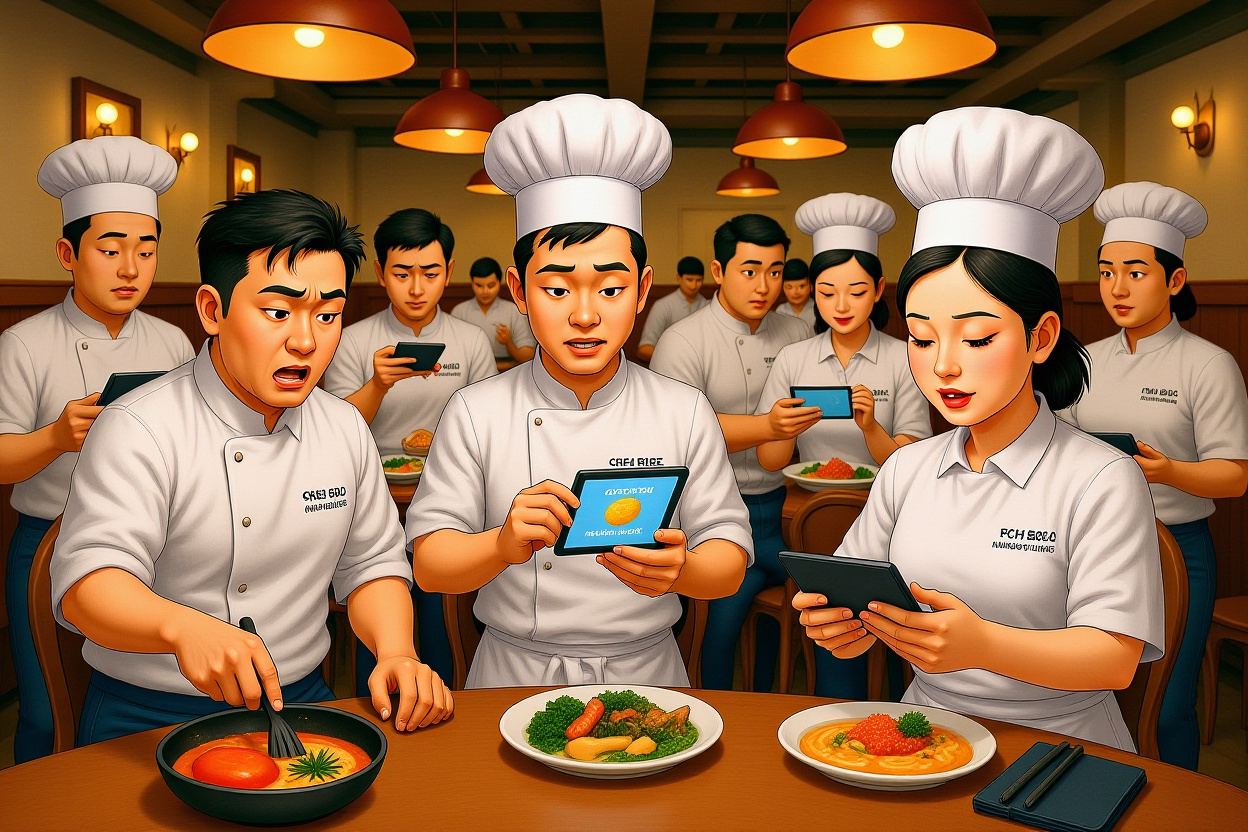On the afternoon of September 10, Luo Yonghao took to his social media account ‘Luo Yonghao’s Crossroads’ to express his frustration after dining at Xibei with colleagues. He discovered that nearly all the dishes were pre-made, yet priced exorbitantly. Luo called for national legislation to mandate restaurants disclose their use of pre-made dishes, sparking a heated debate about transparency and value in China’s dining industry. Pre-made dishes, defined as industrially pre-processed dishes requiring heating before consumption, have become a focal point for both innovation and controversy. This incident underscores growing consumer awareness and dissatisfaction with the lack of clarity in food sourcing and pricing. As pre-made dishes gain traction, the clash between convenience and authenticity raises critical questions about the future of dining. Pre-made dishes are reshaping how restaurants operate, but at what cost to consumer trust? Pre-made dishes represent a significant shift in food service, yet their integration often lacks transparency. Pre-made dishes have evolved from niche products to mainstream offerings, driven by efficiency and standardization. However, as Luo Yonghao’s critique highlights, the disconnect between price and preparation methods fuels public skepticism. This article delves into the rise of pre-made dishes, Xibei’s strategic pivot, regulatory frameworks, and the broader implications for consumers and the food industry. Pre-made dishes are not inherently problematic, but their undisclosed use erodes trust and demands urgent attention. The Rise of Pre-Made Dishes in China’s Food Industry Pre-made dishes have transformed from a convenience niche into a culinary revolution, driven by urbanization, technological advancements, and changing consumer habits. These dishes, which include pre-cut, pre-cooked, or pre-assembled components, allow restaurants to streamline operations, reduce waste, and maintain consistency across locations. For chains like Xibei, pre-made dishes offer a solution to scalability challenges, enabling rapid expansion without compromising on efficiency. However, the industrialization of food preparation raises concerns about quality, authenticity, and value. Pre-made dishes often prioritize shelf life and transportability over freshness and flavor, leading to perceptions of inferiority. Despite this, the pre-made dish market in China has exploded, with projections estimating it to reach over RMB 500 billion by 2025. This growth is fueled by: – Demand for convenience: Busy lifestyles and the rise of food delivery apps make pre-made dishes an attractive option for time-pressed consumers. – Labor and cost savings: Restaurants can reduce kitchen staff and minimize food waste by relying on standardized pre-made components. – Pandemic acceleration: COVID-19 lockdowns boosted at-home dining, driving adoption of pre-made meal kits and ready-to-eat options. Yet, as Luo Yonghao’s experience illustrates, consumers feel misled when high-end restaurants charge premium prices for pre-made dishes without disclosure. Pre-made dishes blur the line between homemade and mass-produced, challenging traditional notions of culinary artistry. Xibei’s Journey into Pre-Made Dishes Xibei, founded by Jia Guolong (贾国龙), has been at the forefront of integrating pre-made dishes into its business model. In September 2019, the chain launched its first pre-made dish product, Lamb Spine Hot Pot, testing the waters for broader adoption. By December 2019, Xibei officially rolled out ‘Jia Guolong’s Kung Fu Cuisine,’ a line of pre-made dishes targeting home consumption. Jia Guolong emphasized that pre-made dishes enabled standardization and variety but insisted Xibei was not becoming a ‘pre-made dish company.’ Instead, he framed it as enhancing operational efficiency and product consistency. This strategic pivot allowed Xibei to tap into the growing demand for convenient, restaurant-quality meals at home. However, the transition has not been seamless. Critics argue that pre-made dishes dilute the brand’s authenticity, especially given Xibei’s reputation for traditional Northwestern Chinese cuisine. The use of pre-made dishes in dine-in settings, as highlighted by Luo Yonghao, exacerbates these concerns when not communicated transparently. Pre-made dishes have become central to Xibei’s expansion strategy, but the lack of transparency risks alienating core customers. Consumer Backlash and the Call for Transparency Luo Yonghao’s critique resonates with a broader consumer movement demanding honesty in food sourcing. Pre-made dishes, while practical, often evoke negative associations with processed foods and reduced nutritional value. When customers pay premium prices at establishments like Xibei, they expect freshly prepared meals, not reheated pre-made components. The backlash underscores a critical gap in China’s dining industry: the absence of mandatory disclosure for pre-made dishes. Consumers feel entitled to know what they are eating and how it was prepared, yet many restaurants omit this information to avoid deterring patrons. This opaqueness fuels distrust and amplifies calls for regulatory intervention. Pre-made dishes thrive in a gray area where marketing emphasizes convenience while downplaying industrialization. Social media amplifies these concerns, as influencers like Luo Yonghao leverage their platforms to hold brands accountable. His post sparked widespread discussion, with many users sharing similar experiences of disappointment and feeling overcharged. Pre-made dishes are not the issue; the problem lies in misleading pricing and communication. Key consumer grievances include: – Perceived value mismatch: High prices for pre-made dishes feel unjustified compared to freshly cooked alternatives. – Health and quality concerns: Consumers worry about additives, preservatives, and nutrient loss in pre-made products. – Ethical considerations: Transparency is viewed as a basic right, not a luxury. Pre-made dishes will continue to face scrutiny until restaurants adopt clearer labeling practices. Regulatory Landscape and Government Response In response to growing concerns, Chinese authorities have begun addressing the pre-made dish phenomenon. In March 2024, the State Administration for Market Regulation, alongside the Ministry of Education and the Ministry of Industry and Information Technology, issued the ‘Notice on Strengthening Food Safety Supervision of Pre-Made Dishes and Promoting High-Quality Industry Development.’ This directive mandates that food businesses adhere to strict standards regarding ingredients, processing, storage, and transportation of pre-made dishes. It also advocates for clear disclosure in餐饮 settings, ensuring consumers are informed about the use of pre-made components. However, the guidelines stop short of requiring mandatory labeling, leaving implementation to the discretion of individual establishments. This regulatory gap allows restaurants like Xibei to continue using pre-made dishes without explicit communication, perpetuating consumer frustration. Pre-made dishes represent a regulatory challenge, balancing innovation with consumer protection. The government’s cautious approach reflects the industry’s economic significance while acknowledging the need for oversight. Pre-made dishes are here to stay, but their integration must be coupled with greater accountability. Implications for the Food Industry and Restaurants The pre-made dish trend is reshaping the culinary landscape, offering both opportunities and challenges for restaurants. For chains, pre-made dishes enable consistency, reduce operational complexity, and facilitate expansion. They also open new revenue streams through retail and e-commerce channels, as seen with Xibei’s Kung Fu Cuisine line. However, overreliance on pre-made dishes risks homogenizing menus and eroding brand differentiation. Restaurants that built their reputation on fresh, artisanal preparation may lose their competitive edge if perceived as merely reheating pre-made components. The key lies in striking a balance between efficiency and authenticity. Pre-made dishes are not inherently negative; their strategic use can enhance offerings when communicated honestly. For example, some establishments openly market pre-made dishes as convenient options for takeaway or delivery, reserving fresh preparation for dine-in customers. This segmented approach maintains transparency while catering to diverse consumer preferences. Pre-made dishes also drive collaboration between restaurants and food tech companies, fostering innovation in packaging, preservation, and flavor retention. Yet, as Luo Yonghao’s critique demonstrates, failing to align pricing with preparation methods can trigger backlash. Pre-made dishes demand a recalibration of value propositions and communication strategies. The Future of Dining: Transparency and Innovation The controversy surrounding pre-made dishes signals a broader shift toward conscious consumption. Diners increasingly prioritize not only taste and convenience but also ethical sourcing and transparency. Restaurants that embrace open communication about pre-made components can build trust and loyalty, turning a potential negative into a competitive advantage. Technological advancements, such as blockchain for supply chain tracking or QR codes detailing ingredient origins, could revolutionize how pre-made dishes are perceived and consumed. By leveraging these tools, restaurants can demystify pre-made dishes and highlight their quality and safety standards. Pre-made dishes are evolving beyond mere convenience into sophisticated culinary solutions, but their acceptance hinges on honesty. The industry must proactively address consumer concerns through: – Clear labeling: Disclosing the use of pre-made dishes on menus and packaging. – Tiered pricing: Adjusting costs to reflect preparation methods, with pre-made options offered at lower price points. – Education: Informing customers about the benefits and processes behind pre-made dishes, dispelling misconceptions. Pre-made dishes are poised to remain a staple in modern dining, but their integration must be transparent and consumer-centric. The debate ignited by Luo Yonghao’s comments is a catalyst for change, pushing the industry toward greater accountability. Pre-made dishes can coexist with traditional cooking if managed with integrity and innovation. Conclusion: Navigating the Pre-Made Dish Dilemma Luo Yonghao’s critique of Xibei underscores a critical juncture in China’s dining industry. Pre-made dishes offer undeniable benefits in efficiency and scalability, but their undisclosed use undermines consumer trust and perceived value. The call for mandatory disclosure reflects a growing demand for transparency, urging restaurants to rethink their approach to pre-made integration. As regulations evolve and consumer awareness heightens, brands must prioritize honesty in their messaging and pricing. Pre-made dishes are not the enemy; opacity is. By embracing transparency, restaurants can harness the potential of pre-made dishes while maintaining customer loyalty. The future of dining lies in balancing innovation with authenticity, ensuring that pre-made components enhance rather than diminish the culinary experience. Pre-made dishes are reshaping food service, but their success depends on ethical practices and open communication. Consumers hold the power to drive change through their choices and voices. Support establishments that value transparency and demand clarity where it is lacking. Pre-made dishes are here to stay—let’s ensure they are part of a fair and honest dining ecosystem.
Luo Yonghao Slams Xibei’s Pre-Made Dishes: High Prices, Low Transparency




